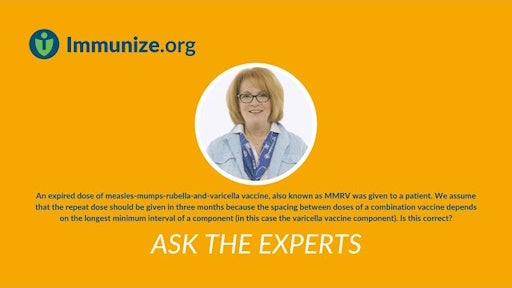ProQuad was licensed in 2005 for use in children ages 12 months through 12 years. It combines the measles-mumps-rubella (MMR) and varicella vaccines and therefore can be used in place of the individual MMR and varicella vaccines given at ages 12–15 months and 4–6 years. For more information, consult the package insert at www.merck.com/product/usa/pi_circulars/p/proquad/proquad_pi_4171.pdf.
Last reviewed:
July 15, 2023
Post-licensure studies of MMRV suggested that, during the 5–12 days after vaccination, approximately one additional febrile seizure occurred among every 2,600 children ages 12 through 23 months vaccinated with a first dose of MMRV vaccine compared with children in the same age group vaccinated with separate first doses of MMR vaccine and varicella vaccine administered during a single office visit.
For this reason, the recommendations for use of MMRV vaccine are as follows:
- The routinely recommended ages for measles, mumps, rubella, and varicella vaccination are age 12 through 15 months for the first dose and age 4 through 6 years for the second dose.
- For the first dose of measles, mumps, rubella, and varicella vaccines at age 12 through 47 months, providers may use either MMR vaccine and varicella vaccine or MMRV vaccine. Providers who are considering administering MMRV vaccine should discuss the benefits and risks of both vaccination options with the parents or caregivers. Unless the parent or caregiver expresses a preference for MMRV vaccine, CDC recommends that providers administer MMR vaccine and varicella vaccine for the first dose in this age group.
- For the second dose of measles, mumps, rubella, and varicella vaccines at any age (15 months through 12 years) and for the first dose at age 48 months and older, use of MMRV vaccine generally is preferred, if available, over separate injections of its equivalent component vaccines (i.e., MMR vaccine and varicella vaccine).
- A personal or family (e.g., sibling or parent) history of seizures of any etiology (i.e., cause) is a precaution for MMRV vaccination, and such children generally should be vaccinated with MMR vaccine and varicella vaccine.
The complete recommendations for the use of MMRV vaccine are available on CDC’s website at www.cdc.gov/mmwr/pdf/rr/rr5903.pdf.
Last reviewed:
July 15, 2023
Absolutely not. Vaccines should never be mixed except when specifically approved by FDA and packaged for that specific purpose.
Last reviewed:
July 15, 2023
Twelve weeks. The spacing between doses of a combination vaccine depends on the longest minimum interval of a component. The minimum interval between doses of MMR is 4 weeks; the minimum interval between doses of varicella vaccine is 12 weeks for a child this age. So, you should wait 12 weeks between the doses of MMRV for the two doses to be valid.
Last reviewed:
July 15, 2023
In the case of an expired live vaccine, the issue is not necessarily the routine minimum interval (three months in the case of varicella and ProQuad vaccines), but the interval that would prevent viral interference if the expired vaccine happened to be still viable. This interval is considered to be four weeks (28 days). The repeat dose should be administered four weeks after the expired dose.
Last reviewed:
February 27, 2025
Last reviewed:
May 23, 2023
Yes, however, this issue is not addressed in the 2010 MMRV ACIP recommendations. Although this is off-label use, CDC recommends that when a dose of MMRV is inadvertently given to a patient age 13 years or older, it may be counted towards completion of the MMR and varicella vaccine series and does not need to be repeated.
Last reviewed:
February 27, 2025
